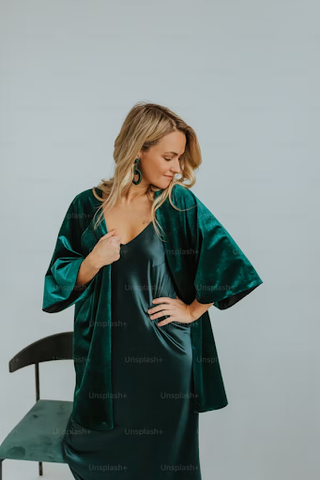Bathrobes vs Dressing gowns: Exploring styles, fabric, differences & more
Have you ever wondered what’s the true distinction between a dressing gown and a bathrobe?
Let's face it, after a shower, we've all undoubtedly thrown on that comfortable robe without really thinking about it.
The terms bathrobe and dressing gown often need clarification for being the same product. Yet they do refer to different products.
Defining Bathrobes and Dressing Gowns:
The difference between a dressing gown and a bathrobe is pretty self-explanatory.
A dressing gown is a type of clothing that is loose-fitting and is worn over other clothing items. It is usually made from a light and thin fabric such as cotton or silk.
A bathrobe, on the other hand, is a type of robe that is worn specifically to dry oneself after a bath or shower. It is typically made from a heavier and more absorbent material such as terry cloth or microfiber.
Key Characteristics and Usage:

One of the most significant differences between a dressing gown and a bathrobe is their design.
-
A robe typically has long sleeves and reaches down to the ankle, with a belt that fastens around the waist to keep it closed.
-
In contrast, a bathrobe is shorter and more open in design, often with a simple tie or snap closure in the front.
Another difference between dressing gowns and bathrobes is their intended use.
-
A dressing gown is typically worn as a form of loungewear or sleepwear, whereas a bathrobe is only worn after bathing or showering.
-
A bathrobe could be worn without anything underneath according to one's comfort whereas a dressing gown is always worn as an article of outer clothing.
-
This is mainly because bathrobes are designed to be more absorbent and to help dry the body more effectively while dressing gowns are intended for relaxation or comfort.
-
While both garments serve similar purposes of providing comfort and coverage at home, bathrobes are more functional and dressing gowns are more about leisure. While some people do sleep with bathrobes on, it's not the most common practice.
-
Dressing gowns have evolved to better fit modern lifestyles. While might no longer be a daily essential for everyone, they remain a popular choice for comfort, relaxation, and even a touch of luxury.
The key lies in personal preferences and how you wish to incorporate them into your life.
Popular Bathrobe and Dressing gown materials:

Cotton:
Dressing gowns are made from a soft and breathable material that's hypoallergenic and feels amazing on your skin.
Terry Cloth:
High-quality cotton is woven into loops to make highly absorbent and warm terry cloth towelling robes. They're much more absorbent than non-looped cotton robes and are great for drying off after a shower or swim.
Silk:
This is a shiny fabric that feels smooth and luxurious against the skin. While silk robes are not warm or absorbent, they are popular with women who wear them in the summer months around the house or pool.
Satin:
Much like silk, satin is a smooth, elegant, and lightweight fabric. It's more affordable than silk and is great for wearing around the house, at the spa, or on a summer holiday.
Flannel:
Flannel is a soft, warm fabric that makes for a classically comfortable bathrobe. Typically made from a blend of cotton and wool, it has absorbing and insulating properties.
Chenille:
This is a lightweight material that's typically polyester blended with cotton or wool. It's plush, durable, insulating, and inexpensive, but lacks absorbency. Chenille is a great option if you like a robe with a fuzzy texture!
Fleece:
Made from polyester, fleece is a warm, lightweight, and quick-drying material that is plush and soft. It's akin to being wrapped up in a comfy blanket!
Velour:
If you're looking for a thick, warm robe that looks and feels like velvet, then velour is the material for you.
Robes come in many colours, unique designs, and various styles.
While a classic white, fluffy towelling robe is extremely popular, the style you choose all depends on your preferences.
Perhaps you want something thick and fluffy to lounge around the house in. Or maybe you are more interested in a silky robe you can wear over lingerie.
If you want to know the best bathrobe materials, read this.
Bathrobe styles:
Some of the common bathrobe styles include:
-
A shawl-style robe with a large collar that drapes over the neck
-
A hooded robe – great for extra warmth and drying wet hair
-
A Japanese-style kimono robe, typically made from satin or silk, has wide sleeves and no collar
-
A double-breasted robe
-
A robe with deep pockets
-
A robe with embroidery design – ideal if you want to add your logo or initials
Dressing Gown Styles:
Here are some of the dressing gown styles
-
Shawl Collar: Classic and cosy, perfect for snuggling with its wide, plush collar.
-
Kimono: Luxurious and elegant, inspired by Japanese garments with wide sleeves and no closure.
-
Belted: Versatile and adjustable, comes with a sash for a secure fit in various fabrics.
-
Hooded: Extra warmth and drying power, with a hood to keep your head and hair comfortable.
-
Short: Mobile and lighter option, ideal for warmer weather or quick errands.
-
Waffle Knit: Cozy and insulating, perfect for colder climates or extra warmth.
How to Wear both:

It's not too hard to put on a dressing gown or bathrobe, but there are a few considerations for optimal comfort and style:
-
Slide in: With the opening in the front of the robe, slip your arms through the sleeves while supporting the robe by the neckline.
-
Wrap it up: To ensure a tight yet snug fit, cross the left panel over the right panel at the waist.
-
Tie it tight: The majority of robes feature a sash to fasten the closing. The sash should be wrapped around your waist and tied in a tight bow or knot. Depending on your style, you can go for a basic front knot or a more complex double wrap.
-
Modify and accessorize: For a well-fitting fit, adjust the shoulder seams as needed.
Let's look at some of our cool bathrobe designs
Take a look into our full range of women's bathrobes here.
Main Differences:
-
Bathrobes are loose-fitting outer garments while dressing gowns are long and loose robes or coats.
-
Bathrobes are made of thick and heavy materials while dressing gowns are made of soft and light materials.
-
Bathrobes absorb water from the body while dressing gowns do not.
-
Bathrobes are worn after taking a shower to relax while dressing gowns can be anytime while in the house.
Similarities:
-
Both are long loose garments that are worn indoors.
-
Both are used to cover the body when partially dressed.
-
Both are open in front and can be closed with a belt.
-
Both are worn by men and women.
Popularity and Cultural Significance:
Bathrobes and dressing gowns are frequently used interchangeably, yet they have different cultural connotations and levels of popularity.
-
More commonly, bathrobes are associated with coziness and self-care, thanks to the media and spa visits. Imagine luscious terry cloth and indulgence after a shower.
-
Dressing gowns radiate elegance and relaxation, reflecting personal style and occasionally even status. They are typically more expensive and regional popularly used in the UK and Europe. Imagine elegant lounging and sumptuous silk.
-
Dressing gowns offer comfort, warmth, and style, making them a popular choice for relaxation and leisure regardless of gender.
-
In the end, both provide warmth and comfort, changing to suit our wants and preferences while continuing to be enduring cultural icons that envelop us in leisure.














